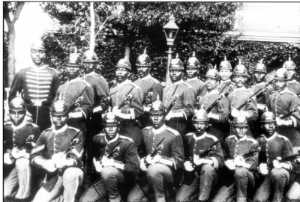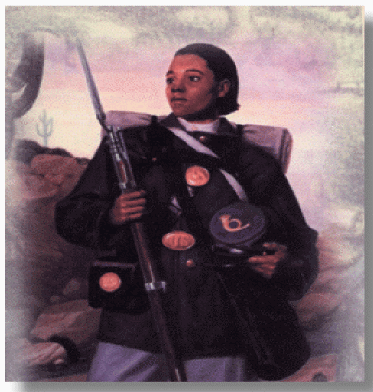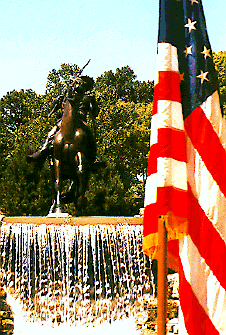
''Buffalo Soldiers" is the name given to African-American soldiers who served the United States in various battles and wars following the Civil War. The Buffalo Soldiers consisted of former slaves, freemen, and African-American who fought in the Civil War. There is more than one theory about why the Indians gave them their name . One theory that they were named Buffalo Soldiers is because their short curly hair resembled that of a buffalo. Another theory is that the name resulted from the heavy buffalo robes the soldiers wore. Others say the soldiers strength and courage was identical to the buffalo when it was wounded.
After the Civil War, there were many African-American soldiers left without homes or jobs, southerners didn't want to see armed African-Americans near their communities, and African-Americans didn't have many employment opportunities. These are some reasons why the Congress established six all African-American peacetime units: the 9th and 10th Cavalries and the 38th , 39th, 40th, and 41st Infantry Regiments. Later, in 1869, the 8th and 41st Infantry Regiments consolidated to form the 24th Infantry Regiment. Later, the 39th and 40th Infantry Regiments consolidated to form the 25th Infantry Regiment, There about 1,000 men in each regiment.
.
The 39th and 40t Infantry Regiments.
The 25th Infantry Regiment was organized at Jackson Barracks, Louisiana in April 1868. The 9th Cavalry was established in New Orleans, Louisiana in 1866. It was commanded by Edward Hatch, and their motto was " We Can: We Will." The 10th Cavalry was formed at Fort Leavenworth, Kansas in 1868. It was led by Benjamin Grierson, their motto was " Ready and Forward." African-Americans joined the military because, in addition for the chance to serve their country, the army offered shelter, educational opportunities, steady pay, medical attention, and a pension. Because at the time White men took many of the better jobs, the Buffalo Soldiers included many highly educated African- Americans who were usually more intelligent and capable than the average White soldier.
Throughout the Indian Wars, the Buffalo Soldiers fought in over 177 battles, including battles with the Kickapoo Indians, the Kiowa Indians, the Comanche Indians, and their biggest challenger, the Apache Indians. In the Battle of Beecher Island, the Buffalo Soldiers rescued General Forsyth's men, who had been captured by the Cheyenne and Ogala Indians.
In addition to the many battles the Buffalo Soldiers fought in, they carried out many other duties for the army and western settlers. They fought off Mexican bandits, cattle thieves, and murderers. They helped to move Indian families to reservations, and they rode after Indians who tried to leave the reservations. The Buffalo Soldiers explored and mapped vast areas of the Southwest and strung hundreds of miles of telegraph lines. They also escorted settlers, cattle herds, and railroad workers through Indian territory.
The Buffalo Soldiers continued to serve in the military after the Indian Wars. In the 1890's, following the Indian Wars, the Buffalo Soldiers were sent to Cuba. In the 1898 they helped to secure San Juan Hill, fighting alongside future President Theodore Roosevelt and his Rough Riders. One eyewitness wrote that, "If it had not been for the Negro Cavalry, the Rough Riders would have been exterminated." In 1903 some Buffalo Soldiers patrolled national parks in California. The many wars and battles Buffalo Soldiers have participated in include Spanish-American Was, the Philippine Insurrections, the Mexican Expedition, World War I, World War II, and the Korean War.
The Buffalo Soldiers were exposed to harsh discipline, tough officers, and poor food and recreational facilities. The only bathing facilities usually consisted of a local creeks, so diseases were common. In 1866 at Fort Leavenworth, at least one Buffalo Soldier died due to disease, mainly cholera, during each month for the first ten months of the year. Work was seven days a week except for Christmas and the Fourth of July, and pay was only $13 per month. Despite there hard conditions, the Buffalo Soldiers excelled. During the years from 1870 to 1880, the Buffalo Soldiers wore a dark flannel shirt with light blue trousers, tall boots, a blue Civil War hat, and a neckerchief of their choice. Although a neckerchief was needed to keep the dust away from their faces, the Army would not issue one to the Buffalo Soldiers.
In addition to being assigned some the worst jobs the Army had to offer, the Buffalo Soldiers endured many more obvious acts of discrimination. Many White officers refused to command the African-American units. The Army and Navy Journal illustrated this: "A First Lieutenant of Infantry (White) stationed at a very desirable post ..... Desires a transfer with an officer of the same grade, on equal terms if in white regiment; but if in a colored regiment, a reasonable bonus would be expected." General George Armstrong Custer was one of the officers who refused to command African-Americans units. However, Buffalo Soldiers ended up saving General Custer and his men when when they were trapped in a battle. The Army supported segregation by providing separate facilities for Buffalo Soldiers and White soldiers. The Buffalo Soldiers helped to build many forts that they were not allowed to use. Buffalo Soldiers were ambushed not only by their enemies, but were also sometimes attacked by the townspeople that they protected. There were many targets for snipers and sometimes became caught up in shootouts just for entering some towns, mostly in Texas.
Although women soldiers could not serve in the military at the time, the Buffalo Soldiers also included one women in their ranks. Cathay Williams was born in Independence, Missouri in 1844. During the Civil War, Union soldiers took her and other slaves and made them cook and wash clothing for the Union troops. Army papers show that, on November 15, 1866, she enlisted in the 38th Infantry Regiment United States Army in St. Louis, Missouri. According to an article in the St. Louis Daily Times dated January 2, 1876. She joined the army to be near her cousin and a friend who were soldiers. She also wanted to earn her own living and not dependent upon family or friends. She was 22 years old and five feet, nine inches tall when she enlisted. Her name was listed as William Cathay. Army documents show that she was hospitalized five times, but no one discovered she was a women posing as a man. The St. Louis Daily Times article state that she was tired of army life and sought a discharge by complaining of pains in her side and knees. The doctor examined her, discovered she was a woman, and she was discharged from the army on October 14, 1868. After she left the army, she lived in Colorado.

Cathay Williams serving in the army.
The contributions of the Buffalo Soldiers weren't well recognized for many years, but they are now becoming better known and honored for their service. The America's Buffalo Soldier Re-Enactors Association (ABSRA) was founded in 1990 and works toward honoring the Buffalo Soldiers. General Colin Powell helped to recognize the Buffalo Soldiers as heroes with the dedication of the Buffalo Soldiers monument at Fort Leavenworth, Kansas in 1992.

The monument that General Colin Powell dedicated to the Buffalo Soldiers.
Today, a unit known as the Buffalo Soldiers is fighting in Iraq. The First Squadron, 10th Cavalry is now an integrated unit that is considered one of the most mobile units in the United States Army. The Unit is commanded by Lieutenant Colonel Reginald Allen, the first African-American to command a Buffalo Soldier unit. Lieutenant Colonel Reginald Allen commented on the important contributions of the Buffalo Soldiers in a recent interview. He stated, "The incredible thing about the Buffalo Soldiers, especially those who served early on, is that they loved this country enough that through the racism, through the bigotry, they still wanted to serve. They wanted to better themselves and serve the nation. They served with less than the best equipment and less than the best provisions at the farthest and most remote outposts in the United States. They served with pride and honor and professionalism. That is absolutely no different that what the buffalo Soldiers today are doing."
Allyson Porter
8th American History
Rossville Jr. High
Plains History Project
2004